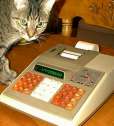Casio fx-50F
| Datasheet legend
Ab/c:
Fractions calculation
AC: Alternating current BaseN: Number base calculations Card: Magnetic card storage Cmem: Continuous memory Cond: Conditional execution Const: Scientific constants Cplx: Complex number arithmetic DC: Direct current Eqlib: Equation library Exp: Exponential/log functions Fin: Financial functions Grph: Graphing capability Hyp: Hyperbolic functions Ind: Indirect addressing Intg: Numerical integration Jump: Unconditional jump (GOTO) Lbl: Program labels LCD: Liquid Crystal Display LED: Light-Emitting Diode Li-ion: Li-ion rechargeable battery Lreg: Linear regression (2-var. stats) mA: Milliamperes of current Mtrx: Matrix support NiCd: Nickel-Cadmium recharg. batt. NiMH: Nickel-metal-hydrite rech. batt. Prnt: Printer RTC: Real-time clock Sdev: Standard deviation (1-var. stats) Solv: Equation solver Subr: Subroutine call capability Symb: Symbolic computing Tape: Magnetic tape storage Trig: Trigonometric functions Units: Unit conversions VAC: Volts AC VDC: Volts DC |
| ||||||||||||||||||||||||||||||||||||||||||||||||||||||||
Casio fx-50F
 Here is a calculator that, despite its small program memory and limited programming model, is nevertheless a machine I almost like. Why? Simple: because it is one of the few programmable models in existence that runs from solar energy.
Here is a calculator that, despite its small program memory and limited programming model, is nevertheless a machine I almost like. Why? Simple: because it is one of the few programmable models in existence that runs from solar energy.
No, I'm not a nutty environmentalist who believes that every electric toothbrush must come equipped with its own solar panel. But there's a great deal of elegance to a circuit, a functioning computer in fact, that uses so little energy, ambient light in a moderately lit room is sufficient for it to operate.
That said, 29 program steps is a very small amount of program space. Were it not for this machine's fully merged programming model, it'd be pretty close to useless. With merged program steps, and full memory arithmetic however, it is possible to squeeze moderately complex algorithms into program memory. One example is a program I wrote that computes the Gamma function, to 6+ digits of precision, for any argument; it uses an iterative loop to compute more accurate results for small or negative arguments:
K3: 1/12 (0.0833333333333) K4: 2×π (6.2831853072)+ ln Kin+ 1 9 Min 1 = x<=M × Kin 2 ln - Kout 2 + Kout 4 ÷ Kout 2 ÷ ln x-y 2 + Kout 3 ÷ Kout 2 - 0 x-K 1 =


